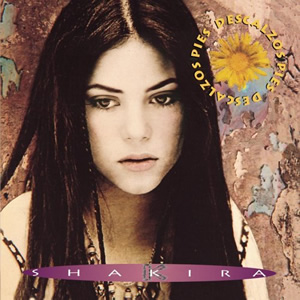
Paulina Susana Rubio Dosamantes is a Mexican singer. Referred to as "The Golden Girl" and "Queen of Latin Pop", she first achieved recognition as a member of the successful pop group Timbiriche from 1982 through 1991. After leaving Timbiriche, she embarked on a solo career. Rubio has sold over 15 million records, making her one of the best-selling Latin music artists of all time.

Dónde Están los Ladrones? is the fourth studio album by Colombian singer and songwriter Shakira, released on 29 September 1998 by Columbia Records and Sony Music Latin. After attaining success in Latin America with her major-label debut, Pies Descalzos (1995), Shakira met producer Emilio Estefan, who identified her potential to break into the US Latin market and became her manager. As co-producer, Shakira enlisted previous collaborator Luis Fernando Ochoa along with Pablo Flores, Javier Garza, Lester Mendez, and Estefan, who executive produced the album. Its music incorporates Latin pop styles, additionally experimenting with rock en español and Middle Eastern music sounds.

Pies Descalzos is the third studio album and the international debut album by Colombian singer and songwriter Shakira, released on 6 October 1995, by Sony Music Colombia and Columbia Records. Its music incorporates Latin pop styles, additionally experimenting with pop rock elements. Looking to revive her struggling career after the commercial failures of her first two studio efforts Magia and Peligro, she assumed a prominent position in its production. As executive producer, Luis Fernando Ochoa co-wrote and co-produced each of the eleven tracks on the record with Shakira.

Jorge Abner Drexler Prada is a Uruguayan musician, actor and doctor specializing in otolaryngology.

Colombian singer and songwriter Shakira has released 11 studio albums, five live albums, two compilation albums, 68 singles and 62 music videos. With estimated sales of 85 million records worldwide as of 2022 according to the recording academy, she is the highest-selling Colombian artist and the best-selling female Latin artist of all time. She is the only South American artist to peak at number one on the Australian Singles Chart, the UK Singles Chart, and the US Billboard Hot 100. Her singles "Hips Don't Lie" and "Waka Waka ", have achieved sales in excess of ten million units, becoming some of the best-selling singles worldwide.

"Ciega, Sordomuda" is a song by Colombian singer Shakira from her fourth studio album, Dónde Están los Ladrones? (1998). A pop rock track, it utilizes mariachi trumpets and lyrically equates total love to a person being blind, deaf, and mute. It was released as the album's lead single on 4 September 1998 by Columbia Records and Sony Discos. The lyrics were written by Shakira. Its music was co-composed by Shakira and Estéfano, while produced by the singer and Lester Méndez.

"Las de la Intuición" is a song by Colombian singer-songwriter Shakira from her sixth studio album Fijación Oral Vol. 1 (2005). It was written and produced by the singer as well as co-composed by Luis Fernando Ochoa, with additional production by Lester Mendez. It was sent to Spanish radio stations on 24 February 2007, as the fourth and final single from the album. "Las de la Intuición" is a synth-pop and Euro house track whose lyrics talk about female intuition. It received mostly positive reviews from music critics, who commended its lyrical content and production. The track was a commercial success in Spain, topping the Airplay chart, and entering the top ten on the Downloads and Original Tones charts, all published by the Productores de Música de España (PROMUSICAE). It received a five-times Platinum certification by the organization for 100,000 ringtones sold, and became the song of the summer of the country in 2007. Elsewhere, it entered the charts in Russia and Venezuela.

Shakira Isabel Mebarak Ripoll is a Colombian singer and songwriter. Born and raised in Barranquilla, she has been referred to as the "Queen of Latin Music" and is noted for her musical versatility. She made her recording debut with Sony Music Colombia at the age of 13. Following the commercial failure of her first two albums, Magia (1991) and Peligro (1993), she rose to prominence in Hispanic countries with her next albums, Pies Descalzos (1995) and Dónde Están los Ladrones? (1998). She entered the English-language market with her fifth album, Laundry Service (2001), which sold over 13 million copies worldwide. Buoyed by the international success of her singles "Whenever, Wherever" and "Underneath Your Clothes", the album propelled her reputation as a leading crossover artist. Broadcast Music, Inc., described Shakira as a "pioneer" who extended the global reach of Latino singers.

"Tú" (transl. "You") is a song by Colombian singer-songwriter Shakira from her fourth studio album, Dónde Están los Ladrones? (1998). On the ballad, the lyrics detail the singer offering herself and her possessions to her lover. It was released as the album's second single in 1998 by Columbia Records and Sony Discos. Its lyrics were written by Shakira, the music was composed by herself and Dillon O'Brian. Shakira also handled its productions along with Lester Méndez. The track's musical composition was originally intended for an album O'Brian never released.

Sale el Sol is the ninth studio album by Colombian singer and songwriter Shakira, released on 19 October 2010, by Epic Records. The album marks a return to Shakira's signature Latin pop sound after the electropop record She Wolf (2009). The singer split the album into three musical "directions": a romantic side, a "rock and roll" side, and a "Latino, tropical" side. The latter two "directions" experiment with rock and merengue music, respectively. As co-producer, Shakira enlisted collaborators including Josh Abraham, El Cata, Gustavo Cerati, John Hill, Lester Mendez, and Residente from Calle 13.
"Despedida" is a song recorded by Colombian singer Shakira for the extended play (EP) and soundtrack Love in the Time of Cholera (2008). The song was written by her and Pedro Aznar originally for the Mike Newell-directed 2007 movie adaptation of Colombian writer Gabriel García Márquez's 1985 novel Love in the Time of Cholera. Antonio Pinto handled its composition and production. Shakira was initially offered a role by the producers of the movie to take part as the main protagonist. However, she refused the offer and accepted to collaborate with the musical team due to her friendship with García Márquez. Musically, "Despedida" is a folk song which discusses nostalgic love sentiments towards a person the protagonist lost.

"La Bicicleta" is a song by Colombian singer Carlos Vives and Colombian singer-songwriter Shakira from Vives' fifteenth studio album Vives (2017) and is also included as an album track on Shakira's eleventh studio album El Dorado (2017). The song was written by both singers, and produced by Andrés Castro and it marks Shakira's first collaboration with a fellow Colombian artist. "La Bicicleta" was intended to be representative of both singers' homelands musical styles in Colombia. It is a song with a mixture of various musical elements - vallenato, pop and cumbia and instrumentally, it features indigenous Colombian wind instruments and accordions. Lyrically, it is a nostalgic song, describing the duo's excursion on bikes to places of their childhood. Music critics reviewed the song positively, praising it for its catchiness and inclusion of various Colombian music elements. The song won two Latin Grammy Awards at the 17th Latin Grammy Awards for Song of the Year and Record of the Year.

The El Dorado World Tour was the sixth world tour by Colombian singer and songwriter Shakira, in support of her diamond certified eleventh studio album, El Dorado. Comprising a total of 54 shows, the tour visited Europe, Asia, North America and Latin America. It was her first tour in seven years, the last being The Sun Comes Out World Tour. The tour began on 3 June 2018, in Hamburg, Germany and ended on 3 November 2018 in Bogotá, Colombia. The tour was set to begin in November 2017, but due to a haemorrhage at Shakira's right vocal chord acquired at her last round of rehearsals, the entire tour was postponed to start mid-2018.

Colombian singer-songwriter Shakira has had a considerable impact on the musical landscape of Latin America and further afield. Further to this her career has seen longevity and cultural reach that has enabled Shakira to be a socially, culturally, and politically influential figure across the world. This has culminated in her receiving the honorific nickname of the Queen of Latin Music. To many she is considered the most recognisable faces of Latin music around the world. With 85 millions of records sold, she is the best-selling Latin female artist of all time. According to Forbes, in 2018 Shakira was the most commercially successful woman in Latin music through her album sales, thus making her one of the best-selling music artists of all time. Vogue writer Carla Ramirez referred to Shakira as the greatest Latin female icon in history and journalist Queralt Uceda from La Vanguardia credits Shakira for being largely responsible for the populatity of Spanish language music on a global level, while others credit her for being the pioneer, popularising Spanish music and paving way for other artists such as Bad Bunny and Karol G who enjoy worldwide popularity today. She is credited with opening the doors of the international market for a new generation of Latin artists.

A Shakira impersonator is an artist who mimics or copies the look and sound of Colombian singer-songwriter Shakira. Professional Shakira impersonators or tribute acts have been around since at least the mid-2000s, and continue to be highly popular due to Shakira's enduring appeal. Some tribute acts have performed in front of thousands of people in both Latin and other countries. Many Shakira tribute acts include in their repertoire a re-enactment of her presentations at awards ceremonies such as the Latin Grammys or her famous appearance at the Super Bowl. Some impersonators have performed on television programs, or in nightclubs and music festivals.

Shakira fandom is the name given to the entire community of fans of the Colombian singer Shakira. The community is made up of people of all ages and different cultures. According to the book "Shakira Una Mirada desde el corazón" Shakira enjoyed a "cult" following in the Hispanic communities especially.

The Colombian singer Shakira has made many live performances around her career, these range from concerts in various countries visited, appearances on television programs, music festivals, charity events, sports. awards and more. The vast majority have been broadcast on television, put on CD, the internet and more, some being distributed for sale.

The musical works of Colombian singer Shakira have drawn the attention of music critics, and journalists, Shakira's songs from her first two international albums are the most analyzed due to their symbology, lyrics and concept of that time. Several of these analyzes have helped to understand a little more the ideals of the singer, her political and religious position as well as her inspirations for her first videos and songs. Likewise, the analysis of these works are used for works in various universities and colleges.

The Colombian singer Shakira throughout her career has been considered a feminist symbol and a representation of (Latin) women globally. Since the beginning of her career, several magazines highlighted her appearance in the audiovisual medium with a "unique" style of a young female artist, differentiating herself from other Latin artists. Currently the lyrics of her songs are analyzed by experts.





















